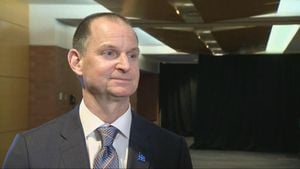Hurricane Milton, the ferocious storm battering the Florida coast, has left the region grappling with destruction and recovery efforts after making landfall as a Category 3 hurricane. Packing sustained winds exceeding 120 mph, Milton crashed onto shore near Siesta Key, stirring up tornadoes and unleashing torrential rainfall across extensive areas. While areas like Tampa avoided the direct hit, they faced heavy rains and strong storm surges, leading to disastrous flooding conditions.
On Wednesday evening, as Milton made its presence known, the surge caused more than 1.5 million customers to lose power statewide, affecting communities from Hardee County to Sarasota and Manatee counties. The storm also set off multiple tornadoes, with reported funnel clouds threatening neighborhoods, particularly evident through dramatic social media footage.
The National Weather Service’s warnings came loudly as impending flash floods, threatening streets and homes, overwhelmed many towns still reeling from the effects of Hurricane Helene, which had left significant damage only weeks prior. Tampa Bay, characterized by its dense population, braced for surge predictions soaring up to 9 feet. Many local officials urged immediate evacuations, particularly as prior storms had already left their marks on susceptible local infrastructure.
Governor Ron DeSantis declared the deployment of considerable resources, which included 9,000 National Guard personnel and over 50,000 utility workers from states as distant as California, tasked with bolstering community recovery efforts. He emphasized the seriousness of Milton's impact, stoically noting, “Unfortunately, there will be fatalities. I don’t think there’s any way around it.”
The day following the storm’s landfall was met with conflicting decisions as many residents struggled to evacuate. Reports indicated families struggling to find accommodations, haul gas for their vehicles, and shouted warnings echoed down the state. “The thing is it’s so difficult to evacuate on a peninsula,” expressed one concerned resident from Sarasota. With many bridges closed and first responders cautioning residents to stay put as the storm raged, thousands felt trapped by the confluence of danger, bad weather, and logistical obstacles.
The aftermath of Milton saw unfortunate direct impacts: approximately 125 homes were claimed by the storm before it even made landfall. Vulnerable communities, like those home to senior citizens, bore the brunt of the destruction, many mobile homes lay destroyed. Emergency management officials were called to action from various counties, pushing limits to garner assistance for overwhelmed residents and neighborhoods.
Notably, the situation at Miller Lake, located within Volusia County, began to draw attention as rising floodwaters increasingly compromised household infrastructure. The DeBary city council hastily organized efforts to assist those suffering significant impacts. DeBary Vice-Mayor Phyllis Butlien acknowledged, “You guys have definitely made the news. Everyone, I think, in the state of Florida knows about Miller Lake.”
The decision to pump floodwaters away from vulnerable areas sparked optimism among local residents. “I wanted to just cry,” noted Catherine Levinson, expressing gratitude as DeBary city staff initiated rescue efforts, labeling them as “riding in on their white horse.” Pumps were set up, and more than 1 million gallons aimed to be diverted daily, illustrating intense community collaboration. “Every inch counts,” remarked Levinson, observing the positive changes made around her home after just 30 hours of pumping.
Nevertheless, the sense of temporary salvation also birthed the knowledge of needed long-term solutions. Residents rallied for the installation of more permanent infrastructure to avert future disasters and emphasized confronting local political bodies about the future of stormwater drainage management for solutions born from these precarious predicaments.
The need for community solidarity grew palpable, with DeBary city manager Carmen Rosamonda urging others within Volusia County to expand their focus beyond mere temporary fixes, expressing, “The county is going to have to step up.”
Authorities had previously released dire warnings, asserting the urgent need for evacuations across more than 15 counties with over 7.2 million residents intertwined, urging them to act before it was too late. The detrimental combination of high winds, torrential rainfall, and cascading tornado strikes played out across the state, continuously influential to local emergencies and joint community responses.
Meanwhile, with already weary citizens following closely behind Hurricane Helene’s aftermath, the power of nature stood like waves of catastrophic revitalizations to government engagement on disaster risk resilience. Reports of local heroes who aided neighbors echoed through various sector representatives, showcasing the human spirit and community cohesion pooling together amid the ramifications of Hurricane Milton.
Hurricane Milton’s legacy could evolve beyond destruction, challenging regional authorities to fortify resilience systems for lessening future storm trauma. An urgent reflection remained prominently shared: Experiences from these hurricanes may be the driving force needed to invoke infrastructure change and community preparedness strategies reflecting Florida's storm-impacted reality.



